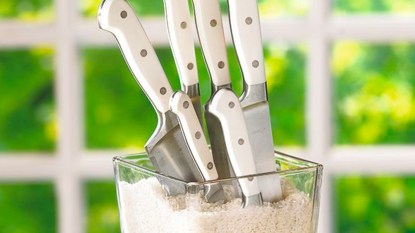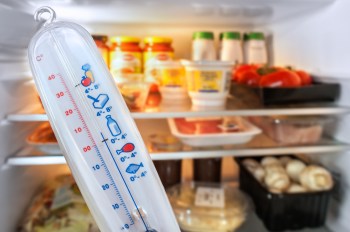3 Ways Your Kitchen Is Causing Your Weight Gain

It’s easy to be confused by all the contradictory health and dietary information we’re bombarded with daily. While most of us instinctively know what we should be eating — real food, not too much of it, and plenty of fresh fruit and vegetables — temptations, habits, and mindless eating often lead us astray. But without us realizing, our kitchens could also be working against our efforts to be healthy. By the same token, a smart kitchen can encourage healthy choices and even lead to weight loss — the experts explain how.
1. It’s all in the display.
Food psychologist and author of Slim By Design ($16, Amazon), Brian Wansink, PhD, has researched how “mindless eating” habits can be channeled into making better health choices.
“One thing we’ve found is any food that’s on your kitchen bench is more likely to be eaten than food which isn’t,” he says. “Our study showed if you have chips or biscuits on your kitchen bench, you weigh about 10 pounds more than your neighbor who doesn’t. If you have breakfast cereal visible anywhere on the bench, you’re going to weigh about 20 pounds more than your neighbor.”
Conversely, having healthy foods on display can produce measurable health benefits. “People with fruit bowls weigh almost 13 pounds less than their neighbor who [doesn’t have one],” Wansink says. “It’s like you see it and go, ‘That’s an idea, I’ll have an apple.'”
Zoe Bingley-Pullin, celebrity chef, nutritionist and founder of Falling in Love with Food, says a well-maintained kitchen can contribute to healthier choices. “Keeping the kitchen clean and free of mess avoids feelings of chaos, which can lead to poor food choices or opting to call [for takeout].”
2. Avoid storing treats at eye level.
How and where food is stored can have a huge impact on dietary choices — those same tricks that supermarkets use to encourage us to buy are also at play in our own kitchens. “Avoid storing ‘treats’ at eye level so when reaching for a snack, treats aren’t right before your eyes,” Bingley-Pullin suggests. “You’re three times more likely to eat the first food you see than you are the fifth food you see,” says Brian. “Our research shows one of the most basic — and easiest — changes to make is ensuring the first foods you see when opening your fridge or pantry are the healthy ones you want to eat more of.”
A kitchen well-stocked with healthy foods will always lead to healthier eating choices, and to help you achieve this, Bingley-Pullin recommends keeping a shopping list in a handy spot (such as on the fridge door), writing down exactly what you need to purchase each week, and only buying what is on the list to avoid impulse buys.
3. Plate up, or down.
Even the size of our plates can influence weight gain or loss because it has a significant impact on the size of the portions you serve up, even though you may not be aware of it.
“Our research has shown you serve yourself in proportion to the size of the plate you’re serving on,” Wansink explains. “You might put 3 ounces on a 10-inch plate, but if that plate is a little bigger — say 11 inches — you’ll add about 22 percent more.”
In addition to being aware of portion size relative to plate size, Wansink recommends pre-plating food directly from the stove rather than having a big bowl sitting at the dining table, citing an 18-percent reduction in food eaten.
This post was written by Homes to Love editors. For more, check out our sister site Homes to Love.
More From FIRST
How to Clean a Microwave in Under 10 Minutes
Best News Ever: You Can Eat Pasta and Still Lose Weight, Study Finds
Put an End to Overeating and Slim Down With the Dissociated Diet













